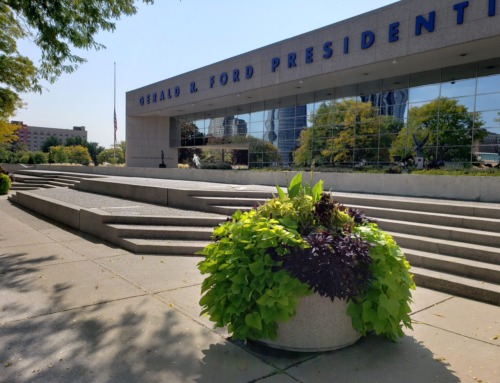Every Memorial Day Weekend, a group of individuals dressed as American Indians from the upper part of Michigan gather in front of Fort Michilimackinac in Mackinaw City to play baggataway, which is an early version of lacrosse. The game is carefully scripted. Many spectators gather, some of whom are dressed as American Indian women and children.The reenactors are not simply playing the game for enjoyment. “The Pageant” is actually depicting a part of Pontiac’s Rebellion, which was an intricate, well-planned attack on many British outposts in the Great Lakes region in 1763.
Tensions had been brewing between the Natives and the British for quite some time. Decades earlier, France and Britain fought in a series of wars throughout the known world, one being the French and Indian War. This was fought on American and Canadian soil between the British with their Native allies and the French with their Native allies. In 1760, British General Jeffrey Amherst captured the last important French settlement, Montreal. In Michilimackinac and Detroit, the passing of power from France to Britain was quite peaceful, and many French families were allowed to stay in these forts and continue trapping and trading furs. However, it wasn’t long before the British began breaking their promises to the Natives of the area.
The Treaty of Easton promised that British civilians in North America wouldn’t settle west of the Allegheny Ridge, leaving that area to the Natives. This part of the agreement was not respected by colonists who saw the immense value of the fertile lands. General Amherst, still in charge of American Indian policies, believed that the Natives would have no other choice than to accept British rule and felt they would be unable to resist the British Army. Amherst began to cut back on giving gifts to the Natives, a practice that previously had been a vital part of the friendly relationship between the British and Native tribes. Amherst also began to restrict the amount of ammunition and gunpowder that was sold to the Natives and he treated them with contempt.
The Native Indian tribes began to come together, fearing that the British were preparing to attack them. The tribes were led by Chief Pontiac of the Ottawas and a plan was set into motion. The Natives assaulted Fort Detroit first, though the soldiers there had been forewarned and were able to resist the initial attack. Pontiac’s confederacy surrounded the fort from May 6 until October 31. More than 900 Indian warriors joined in the siege, and a number of British soldiers and civilians who lived on the land surrounding the fort were killed. French settlers were left alone because of the positive relationships that had been cultivated for decades between the two groups. The British soldiers at Detroit eventually received reinforcements, and Pontiac lifted the siege and traveled South to the Maumee River to rally his warriors. Eight British forts in all were taken in the region during this time by other Native confederacies.
Fort St. Joseph was captured rather quickly by the Potawatomi on May 25, 1763. The warriors killed most of the fifteen-man garrison outright and took commander Ensign Francis Schlosser captive. He was brought to Detroit to be ransomed, as was the custom of the time for captured officers. He was later exchanged for Indian prisoners held by the English.
What happened at Michilimackinac was much more dramatic than in Detroit or St. Joseph. A group of Native Ojibwe played the most clever of tricks on the British. There were warning signs of an attack many days before, as French settlers like Charles Langlade told British Major George Etherington about the increasing Native activity in the area. Etherington ignored the warnings and got so salty about the rumors that he threatened to send anyone who spoke of it again to Fort Detroit as a prisoner.
On June 4, 1763, the tribes around northern Michigan devised a plan to get inside the walls of the Fort, smuggle in their weapons and catch the British soldiers and settlers by surprise. Many times the soldiers of the fort would watch the native games of baggataway, so the Natives asked the British soldiers if they would like to watch as the Ojibwe took on the Sauks. It is believed that they told the British that the game was in honor of the British King George III. That should have also given the British a clue of deception, as the relationship was so strained between the Natives and the Crown.
The Natives began the game, and at one point, one of the Ojibwe “accidentally” allowed the ball to go over the stockade wall. It was thrown back by a soldier, and the game continued. A bit later, the same thing happened, but this time, a brave was allowed to retrieve it. The game resumed, and once again, the ball flew over the wall. Many of the players ran towards it, as if their hustling was simply part of the game. However, this was the moment they had really been waiting for. The Native women watching, opened their blankets (the fact that they were wearing blankets on a hot June day should have been another sign to Etherington that all was not as it should be) and handed knives and tomahawks off to the athletes, who were now warriors. Etherington and his next-in-command, William Leslye, were immediately taken. Lieutenant Jamet, the only other officer stationed there, was killed.
During the attack, British fur trader, Alexander Henry, was at the fort preparing a canoe for his return trip to Montreal. Henry, whose memoirs give great detail of this event, heard the battle cries and went to investigate what he described later as a massacre. The French settlers of the fort, again, were left unharmed and reportedly did nothing to try and stop the Native attack. Henry managed to escape the attack by hiding in the basement of one of the French settlers’ houses outside of the fort, unbeknownst to the homeowner. While he survived the initial attack, he was eventually discovered and taken prisoner. Henry did survive and eventually made his way back to Montreal. You can read of Henry’s adventure in more detail in his memoir, a book entitled Attack at Michilimackinac.
Many other forts, both small and large, were attacked by Pontiac and his allies. The total loss of life resulting from the conflict is unknown, but it is estimated that about 400 British soldiers were killed in action and 50 were captured and later killed. It is also believed that 2,000 settlers were killed or captured, and the violence forced about 4,000 settlers from the Pennsylvania and Virginia colonies to flee their homes. The American Indian losses went mostly unrecorded.
While Pontiac’s War was initially called a victory for the British, many historians now consider it a military stalemate. The Native Americans didn’t drive away the British, but the British were unable to conquer the Native Americans. Negotiation and accommodation, not battlefield triumph brought an end to the war. In fact, the American Indians won a victory by persuading the British government to abandon Amherst’s policies and create a relationship with the Native Americans that mirrored the French relations.
Pontiac’s Rebellion is an important part of Michigan and United States history. The reenactors of “The Pageant” know this, and bring this history to life every spring. So if you are ever in Northern Michigan during the Memorial Day Weekend, stop at Fort Michilimackinac for an amazing reenactment and be a witness to one of the most clever attacks in Michigan history.







Leave A Comment
You must be logged in to post a comment.